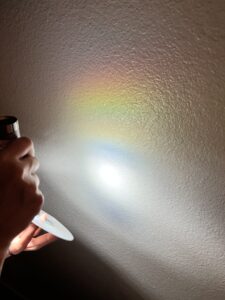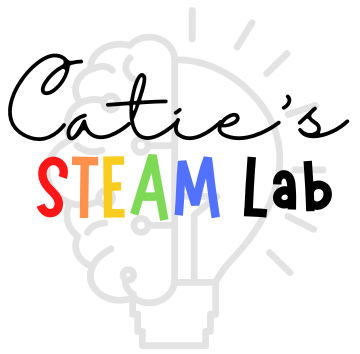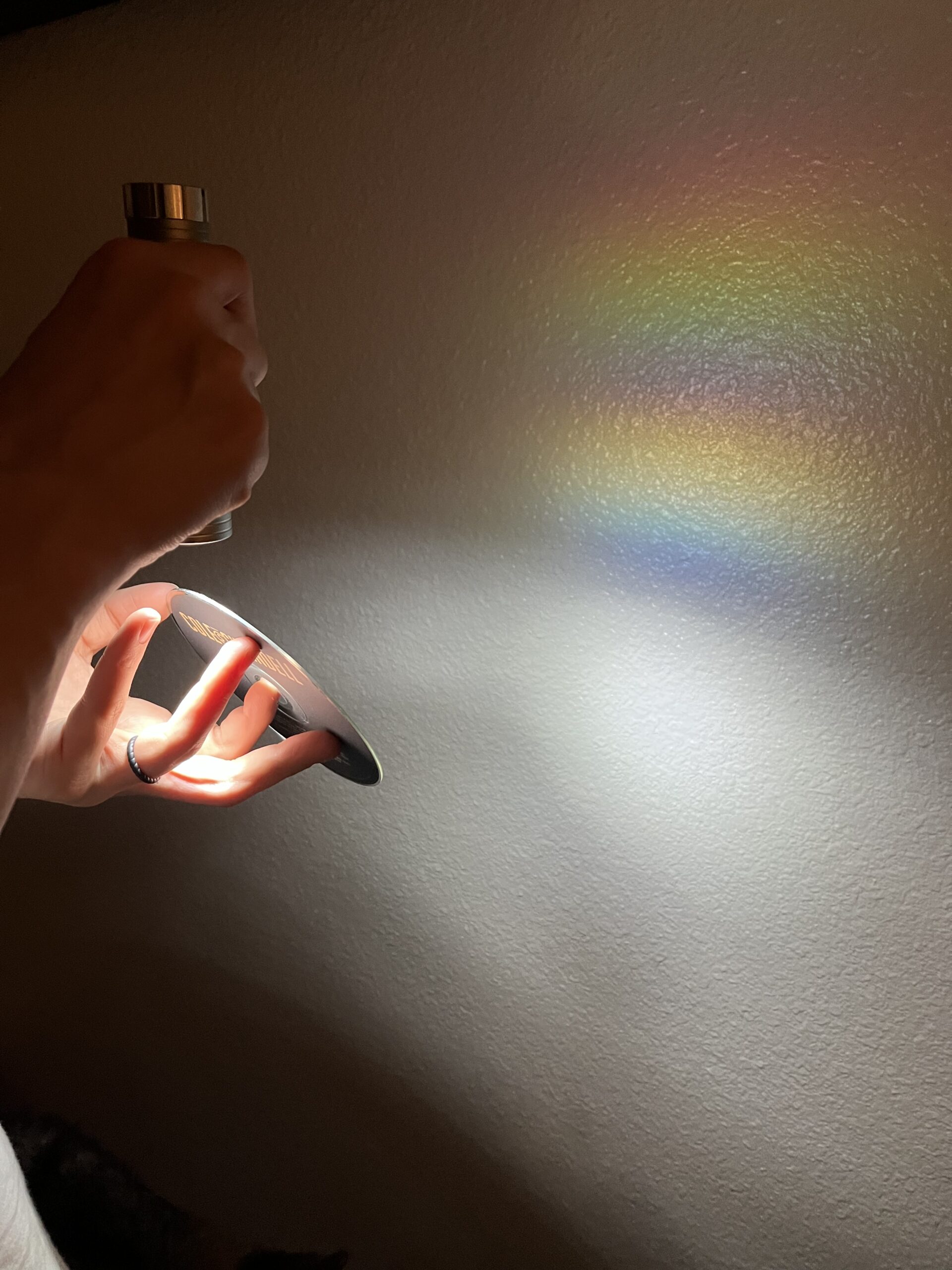There is no hiding it. I LOVE science projects! This week, I’m going a little science heavy this week! I don’t know about you, but with the rainy season here, I have been searching for ways to keep my class and my daughter entertained inside. As spring approaches and we are seeing more rain and sunshine, I’m always on the lookout for rainbows! However, this week has been a gloomy, dark, cloudy week. What is one thing you need to make a rainbow? SUNLIGHT! I know you are wondering how to make a rainbow without sunlight. Well, I’m here to tell you it is completely possible, as so easy to do from home!

Rainbows are one of my favorite things to teach in preschool! Not only is it an introduction to colors, but also, it is a gateway to light science! Not only are rainbows fascinating from a science point of view, but my children love them. We will sit outside or at the window and look at rainbows for at least ten minutes. I know that doesn’t sound like a lot but for a group of three-year-olds, it is! I know your child will love having the power to create their own rainbows as much as mine will!
STEAM Integration
Science
The science of a rainbow seems complicated, but it doesn’t have to be! It involves the visible light spectrum, or the wavelengths of light that we can actually see with our bare eyes. It is a part of the electromagnetic spectrum which is a range of energy that travels in waves. You may be familiar with radio waves, microwaves, infrared radiation, and ultraviolet radiation. These are all a part of the electromagnetic spectrum. Each category of the visible spectrum has their own distinct wavelength. Our eyes can only process the wavelengths that are found in the visible light portion of this spectrum; hence, the reason it is called visible light spectrum.
In the visible light spectrum, which we can see as white light, all the colors of a rainbow are combined. If you are wondering how to make a rainbow, well you need two things, white light, and a reflective surface. Sunlight is so important in making a rainbow because it contains white light. You also need rain to see a rainbow because the raindrops will refract and reflect the light at an angle, allowing all the colors to be seen separately.
Technology
Are you still wondering how to make a rainbow without sunlight? Well, that’s where technology comes in! Use a white light flashlight! I will concede that the rainbows are not as spectacular as they would be with direct sunlight, but it will do the trick! Make sure you are using a white light flashlight and not a yellow light flashlight. A yellow flashlight will not contain the spectrum of colors that you see in a rainbow and; therefore, will not work.
I love introducing technology to my class as well as my daughter. Evie is 18 months and loves light! At the moment, she will take a flashlight, try to turn it on, be amazed when she does, and then try to stare into the light. Just a friendly reminder, please supervise any child with a flashlight, as looking into the light can hurt their eyes! Anyways! For Evie, turning the flashlight on and off is pretty stimulating. She works with the concepts that a button controls the flow of electricity. We will narrate the function of the flashlight or help her develop her language and communication skills by saying “light”, “flashlight”, “button”, “on”, or “off” and allowing her the opportunity to practice repeating us!
Older children might start experimenting with the mechanics of the flashlight, how batteries work and the flow of electricity. I encourage taking apart a flashlight, under supervision, please be mindful of batteries and the dangers they may cause if ingested by children. Not only are they working with their fine motor skills, but they are developing awareness of how this particular item functions. For example, if you put a battery in backwards, the flashlight doesn’t work. You can explain the directionality of electricity and how it only flows one way!
Art
Rainbows contain so many colors it is hard to not include an art section with this activity! First and foremost, use this activity to explore different colors and the order of colors you child sees. Ask them which colors they see. Ask them the shape of the rainbow they see. Tape of piece of white paper to the wall, give your child crayons or colored pencils and allow them to color each color of the rainbow on the paper as they see it!
For this activity, I saw a couple different rainbows. Have your child identify each one on their paper. This is particularly fun when you turn all the lights off and have a fun color party in the dark! You can think of this as the rainbow research portion. Once they have recorded the color pattern in the dark, challenge them to create their own rainbow based on the colors they identified!
How to Make a Rainbow without Sunlight:
This post may contain affiliate links, which means I’ll receive a commission if you purchase through my links, at no extra cost to you. Please read full disclosure for more information.
The best part of this activity is that you do not need much to do it! All I used was:
- A white light flashlight
- An old CD
- White paper
- Crayons
That’s it! This is the method that I had the most success with, but there are a couple other methods you can use as well. For an alternative method, you will need:
- A white light flashlight
- A clear bowl of water
- A small mirror
- White Paper
- Crayons
And of course, you can do this experiment with sunlight, if you are so lucky as to have some. Simply replace the white light flashlight with direct sunlight!
Finally, there is one more method that is worth mentioning, but I have not done myself. You can do this experiment with a prism if you have one at home. I personally, do not have one at home, but it is a totally viable option.
Step 1: Gather Materials
Step 2: Tape up the white piece of paper on the wall for the CD method, or on the counter for the water bowl method.
Step 3: Angle your CD or mirror. This is an important step. The angle of the CD or mirror recreates the refraction and reflection of light that is caused by the raindrops. Enjoy your Rainbow!
BONUS Step 4: Color! Record the colors you see by drawing on the paper with crayons or colored pencils!
That’s It! Now you know how to make a rainbow without sunlight! I encourage you to play with different angles, though I had the most success with about a 45-degree angle. Did you think of any other methods to recreate a rainbow? How did your child like the experiment? What was their favorite part? Feel free to share any thoughts in the comments below! I love hearing how your learning journey is going!

